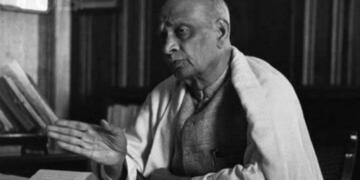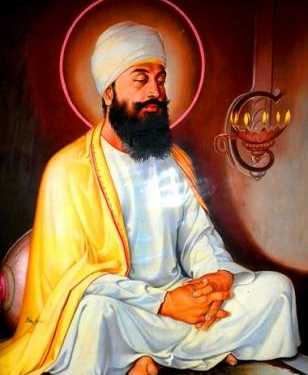Tyag Mal was the youngest of 5 children born to Mata Nanaki and Guru Har Gobind Singh. While spending his childhood days in Amritsar, he developed a penchant for learning philiosophy. Bhai Gurdas identified his craving for learning and taught him Gurmukhi, Hindi, Sanskrit religious texts. Tyag Mal grew up to become a man with immense knowledge of philosophy but his expertise wasn’t limited to just this.
He had also learned archery and horsemanship from Baba Budha and had mastered swordsmanship skills from his father, Guru Har Gobind ji, so when time called he would give the oppressors a befitting reply. On one such occasion, when he was just 13 years old, he joined his father to fight against Painde Khan and the Mughals in the battle of Kartarpur under Shah Jahan’s hawk.
Tyag Mal showed no mercy and made his sword do all the talking. He slashed his enemies left and right and created a havoc among the enemy troop, making a huge dip in their morale. Such was his courage and ability with sword that even the enemies couldn’t help but stand and praise in awe. The Sikhs too, acknowledged young Tyag Mal’s bravery and efforts in the battle field and honored him with the title of “Tegh Bahadur” – the best/bravest sword wielder.
However, young Tyag Mal’s hunger for knowledge kept hounding him and he started spending most of his time in studies or meditation, cut off from the materialistic world, living up to his given name “Tyag Mal” – the master of Renunciation.
After the untimely passing away of his elder brother bhai Gurditta, Tegh Bahadur ji was summoned by his father Guru Har Gobind ji and was asked to move to the village of Bakala along with his mother and wife. Tegh Bahadur ji obliged but spend most of him time in an underground room meditating. It is believed that of these 20 years, he spent 17 years meditating. Around the same time, the then Sikh guru, Guru Har Krishan ji left the mortal world but not before announcing that the next sikh guru would be someone from the village of Bakala. Around 22 different men declared themselves as the next guru and started accepting donations from gullible followers. Makhan Shah, a wealthy trader, was sailing when his ship was caught in a violent storm. He invoked Nanak ji and made a promise to donate 500 gold coins if his ship sailed safely to the shore. And it did. Bound by his promise, Makhan Shah set himself on the road to Bakala. But to his surprise he was dealing with 22 men claiming to be the real guru. Makhan Singh gave them each 2 gold coins and all of them accepted it happily and blessed him. He was about to leave from Bakala when he heard about Tegh Bahadur ji. He decided to pay him a visit and donate 2 gold coins to him too. On meeting Tegh Bahadur ji, he offered him 2 gold coins, to which, Tegh Bahadur ji replied – “Didn’t you promise to donate 500 gold coins, where are the rest of them?”
Makhan Shah was overjoyed, for – he knew only the real guru could know about the promise he made with the God . Makhan Shah ran to the roof of the house and screamed “Guru Ladho! Guru Ladho!” meaning I have found the Guru!.
With this incident Tegh Bahadur ji was accepted as the 9th guru of Sikhism. Though he had all the luxuries of life at his disposal, Guru Tegh Bhadur ji lived austerely. Sikh or other documents make no mention of any clash with the ruling power having occurred during his time.
He was a visionary and wanted to create model cities. For this purpose he bought lands from the villages of Lodhipur, Mianpur and Sahota on which the model city of “Anandpur – the city of bliss” was constructed and this would be the place where later the Khalsa would be born.
But peace was not to stay for long. Oppression and intolerance was raising its ugly head under the Mughal King Aurangazeb. Aurangzeb ordered Hindu temples be razed and idol worship to be considered a sin. He had a temple converted into a Mosque and slaughtered a cow inside it. He also had Hindus sacked from their government jobs and employed Muslims instead. Aurangzeb also ordered Gurdwaras to be destroyed, and he expelled many missionaries from the main cities. Iftikar Khan, one of his generals, was using force to convert the pandits from Kashmir. Aurangzeb believed if he could convert the revered Brahmin Pandits of Kashmir , then millions of followers would easily be converted. Life for Kashmiri pandits had become a living hell. Many a time, just to insult them, Mughal soldiers would sit on their shoulders and ask the pandits to ferry them around. They would be beaten up in public and be humiliated to the point of a break down.
Some of the Kashmiri pandits decided to turn to Guru Tegh Bahadur ji for help. A batch of Kashmiri Pandits left for the holy city of Chakk Nanaki, Pargana Kalhur and requested Guru Tegh Bahadur ji for his help. Tegh Bhadur ji smiled and told them,” Go.. tell the Mughal King if he will be able to convert me – by whatever means he deems fair – then the entire Kashmiri pandit community would convert with him but until he can do that, he should mean no harm to the pandit community” . Word quickly reached Aurangzeb who felt this was a golden opportunity for him to convert the entire pandit community. He sent his soldiers to capture Guru Tegh Bahadur ji and bring him to his court.
Tegh Bahadur ji was captured and brought to Aruangzeb’s court. Aurangzeb made him offers of worldly luxuries but they meant nothing to Tegh Bahadur ji. Realizing that this wasn’t working he ordered force to be used on Tegh Bahadur ji and make him convert. Mughal soldiers tried every possible cruelty on Tegh Bahadur ji but they couldn’t even bring a trace of worry on Guru ji’s face. This was becoming embarrassing for the Mughal king, Tegh Bahadur had become the hero among the pandit community.
Sensing this may lead to his fear among the pandit community getting diminished, Aurangzeb ordered the execution of Tegh Bahadur ji by beheading. Tegh Bahadur ji was beheaded in full public at Chandni Chowkon 24 November 1675. Aurangzeb was left red-faced on not being able to convert “just one man” with all his might.
The sacrifice of Tegh Bahadur ji earned him the title of Hind-Ki-Chadar – “The sheild of Hind”. The other three sikhs arrested with him were also tortured to death by horrific means such as boiling in hot water, cutting by saw and burning alive.
Guru Tegh Bahadur Ji had a versatile personality, a warrior, family man with social commitment and a preacher of great understanding and vision. His martyrdom broke the myth of Aurangzeb’s religiosity.
TFI salutes the great son of India – Guru Tegh Bahadur ji for his supreme courage and sacrifice. _/_
– Sunil Pandey
Sources – Sikh Wiki
Wikipedia
A history of Kashmir
Our moon has blood clots
a few other blogs






























